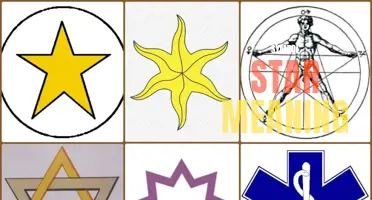
The Olympic symbol is recognized worldwide as a powerful emblem of unity and achievement, representing the highest level of athletic excellence. But have you ever wondered about the meaning behind its iconic design? From the interlocking rings to the vibrant colors, each element of the Olympic symbol carries a symbolic and profound message that reflects the spirit of the Games. In this article, we will delve into the fascinating history and symbolism behind the Olympic symbol, shedding light on its deeper significance and the principles it embodies. So, get ready to discover the hidden stories and inspiring messages behind one of the most recognizable symbols in the world.
What You'll Learn
- What is the meaning behind the Olympic symbol of five interlocking rings?
- How did the Olympic symbol of the five rings come to represent the games?
- Is there a specific significance or symbolism behind the colors used in the Olympic symbol?
- Are there any historical or cultural references associated with the Olympic symbol’s design?
- Has the Olympic symbol and its meaning evolved or changed over time?

What is the meaning behind the Olympic symbol of five interlocking rings?
The Olympic symbol, consisting of five interlocking rings, is one of the most recognizable logos in the world. It represents the Olympic Movement and the values it promotes. The meaning behind the interlocking rings is rich and significant, reflecting the underlying principles of the Olympic Games.
The rings are made up of five different colors: blue, yellow, black, green, and red. Each color represents one of the five continents: Europe, Asia, Africa, Oceania, and the Americas. The interlocking design signifies the unity and friendship among these continents, coming together to celebrate the spirit of the Olympic Games.
Moreover, the colors of the rings were intentionally chosen to ensure that at least one of them appears on the flag of every nation participating in the Olympic Games. This symbolizes the universality and inclusivity of the Olympic Movement, highlighting that the Games are open to athletes from all corners of the world.
The concept of the Olympic rings was first introduced by Pierre de Coubertin, the founder of the modern Olympic Games. He designed the emblem in 1913, and it made its debut in the 1920 Summer Olympics in Antwerp, Belgium. The rings quickly became an iconic symbol of the Olympic Games and have been used ever since.
The interlocking rings have also come to symbolize the five core values of the Olympic Movement: excellence, friendship, respect, courage, and determination. These values represent the spirit of the Games and serve as a reminder of the principles that athletes and participants should uphold.
In addition to representing the continents, the rings also have a deeper meaning. They illustrate the idea of unity, as each color is intertwined with the others, forming a continuous loop. This signifies the power of collaboration and the strength that comes from working together towards a common goal.
The Olympic symbol of five interlocking rings is a powerful representation of the Olympic Movement and its fundamental values. It symbolizes unity, inclusivity, and friendship among the continents, while also embodying the core values of the Games. It serves as a reminder of the international spirit of the Olympics and the power of sport to bring people together.
Decoding the Symbolism Behind the Eyeball: What Does It Mean?
You may want to see also

How did the Olympic symbol of the five rings come to represent the games?
The Olympic symbol of the five rings is one of the most recognizable symbols in the world. It is a symbol that represents the unity and diversity of the Olympic movement. The five rings represent the five continents of the world, coming together in sport and competition.
The idea for the Olympic symbol of the five rings was introduced by Pierre de Coubertin, the founder of the modern Olympic Games. The symbol was first presented to the public in 1913 at the International Olympic Committee's 20th anniversary celebration.
The five rings are colored blue, yellow, black, green, and red. These colors were chosen because they represent the colors found on the flags of all nations at the time. The colors were chosen to symbolize the unity and diversity of the world coming together in the Olympic Games.
Each ring represents a different continent. The blue ring represents Europe, the yellow ring represents Asia, the black ring represents Africa, the green ring represents Australia, and the red ring represents the Americas. Together, the rings represent the five continents of the world and the athletes from these continents coming together to compete in the Olympic Games.
The interlocking rings of the Olympic symbol also have a deeper meaning. The rings are meant to symbolize the friendship and solidarity that exists among the athletes and the people of the world. The rings are interlocked to show that the Olympic Games bring people together, regardless of their differences.
The Olympic symbol of the five rings has become an iconic representation of the Olympic Games and has been used in various forms since its introduction. It is displayed on flags, banners, and official Olympic merchandise. It is also used as the logo for the Olympic Games and is displayed during the opening and closing ceremonies.
In conclusion, the Olympic symbol of the five rings represents the unity and diversity of the Olympic movement. It was introduced by Pierre de Coubertin and has become an iconic symbol of the Olympic Games. The five rings represent the five continents of the world, coming together in sport and competition. The interlocked rings symbolize the friendship and solidarity of the athletes and the people of the world.
The Symbolic Meaning Behind Onyx: Unveiling its Mystical Powers
You may want to see also

Is there a specific significance or symbolism behind the colors used in the Olympic symbol?
The Olympic symbol, consisting of five colored rings interconnected, is a powerful representation of unity and diversity. Each color has its own significance and symbolism, reflecting the values and ideals of the Olympic movement.
The Olympic rings represent the five continents of the world - Africa, Americas, Asia, Europe, and Oceania - and their union through sport. Pierre de Coubertin, the father of the modern Olympics, designed this symbol in 1912, aiming to promote international understanding and friendship among nations.
The colors used in the Olympic symbol are blue, yellow, black, green, and red, arranged in a specific order from left to right. Each color holds its own meaning:
- Blue: Blue represents Europe. It is the first ring on the left because the first Olympic Games took place in Athens, Greece, which is located in Europe.
- Yellow: Yellow represents Asia. This color symbolizes the vibrant and diverse cultures of the Asian continent.
- Black: Black represents Africa. It represents the strength and resilience of African nations and their contribution to the Olympic movement.
- Green: Green represents Oceania. It symbolizes the lush landscapes and natural beauty of the Pacific islands.
- Red: Red represents the Americas. This color symbolizes the passion, energy, and spirit of the American continents.
The interconnected rings of the Olympic symbol represent the unity and equality of all participating nations. They demonstrate that no matter the differences in culture, language, or background, athletes from all around the world come together to compete in the spirit of fair play and sportsmanship.
The colors used in the Olympic symbol also reflect the diversity of the participating nations. By incorporating colors that represent different continents, the Olympic movement emphasizes the inclusive nature of sports and the importance of global cooperation.
The significance of the colors used in the Olympic symbol goes beyond mere visual appeal. They embody the fundamental principles of the Olympic movement, promoting peace, understanding, and friendship among nations. The Olympic symbol serves as a reminder that beyond the competition, the true essence of the Games lies in the celebration of humanity and the power of sport to bring people together.
Decoding the Nissan Murano Dashboard Symbols: Understanding the Meanings Behind the Warning Lights
You may want to see also

Are there any historical or cultural references associated with the Olympic symbol’s design?
The symbols associated with the Olympic Games are iconic and instantly recognizable. From the interlocking rings to the flame, these symbols evoke a sense of athleticism, unity, and respect. But are there any historical or cultural references associated with their design? Let's take a closer look at the origins of these symbols and what they represent.
The most famous of all Olympic symbols is undoubtedly the interlocking rings. Designed by Pierre de Coubertin, the founder of the modern Olympic Games, these rings were introduced in 1913. The five rings, colored blue, yellow, black, green, and red, represent the five continents of the world: Europe, Asia, Africa, Oceania, and the Americas. The interlocking design signifies the unity of these continents coming together in friendly competition, regardless of borders or politics.
Another iconic symbol of the Olympic Games is the Olympic flame. The tradition of the Olympic flame can be traced back to ancient Greece, where the flame was lit by the sun's rays at Olympia. The flame was then carried by a relay of runners to the host city, where it would burn throughout the duration of the Games. This symbolizes the ancient tradition of lighting the Olympic flame and the passing of the torch from one generation to the next.
The olive wreath is yet another historical reference associated with the Olympic Games. In ancient Greece, winners of the Games were presented with a wreath made from olive tree leaves. Olive wreaths were a symbol of victory and honor, and they were highly sought after by athletes. The tradition of presenting winners with a wreath has been carried over to the modern Olympics, although gold, silver, and bronze medals have now replaced the wreaths.
The Olympic motto, "Citius, Altius, Fortius" is a Latin phrase that translates to "Faster, Higher, Stronger." This motto was proposed by Pierre de Coubertin and was officially adopted by the International Olympic Committee in 1894. The motto represents the aspiration and dedication of athletes to surpass their limits and strive for excellence.
In conclusion, the Olympic symbols have deep historical and cultural references associated with their design. From the interlocking rings representing the unity of continents to the Olympic flame symbolizing the passing of the torch, these symbols are rich with meaning and tradition. The olive wreath and the Olympic motto further enhance the historical and cultural significance of the Olympic Games. These symbols serve as a reminder of the enduring legacy and spirit of the Olympic Games and the athletes who participate in them.
Exploring the Symbolic Powers and Meaning Behind Hands
You may want to see also

Has the Olympic symbol and its meaning evolved or changed over time?
The Olympic symbol, consisting of five interlocking rings, has become one of the most recognizable symbols in the world. However, over time, its meaning and interpretation have evolved and changed.
The Olympic symbol was designed by Pierre de Coubertin, the founder of the modern Olympic Games. He believed that the rings represented the five continents of the world coming together in friendly competition. The rings, he said, symbolized the unity of the five continents and the athletes from around the world who compete in the Games.
However, over time, the interpretation of the Olympic symbol has expanded beyond just representing the continents. Today, the rings are often seen as representing the five core values of the Olympic Movement: excellence, friendship, respect, courage, and determination. These values are considered to be the foundation of the Olympic Games and are intended to promote peace, understanding, and sporting spirit among nations.
In addition to their symbolic meaning, the rings also have a practical purpose. The different colors of the rings (blue, yellow, black, green, and red) represent the colors that can be found on the flags of all nations. This is meant to symbolize the inclusivity of the Olympic Games, which welcomes athletes from all countries and backgrounds.
The Olympic symbol has also evolved in its use over time. Originally, it was only used for the Olympic Games themselves. However, it has now become a widely recognized symbol that is used in a variety of ways, including on logos, merchandise, and advertising for Olympic events.
One of the most significant changes to the Olympic symbol occurred in 2011, when the International Olympic Committee (IOC) introduced a new version of the symbol called the "Rings of the Future." This version features the traditional rings, but with a three-dimensional effect and an extra ring, representing the youth of the world.
This change was made to reflect the evolving nature of the Olympic Games and to appeal to a younger audience. The new symbol is meant to symbolize the passion and energy of young athletes and to inspire them to participate in the Olympic Movement.
In conclusion, the Olympic symbol has evolved and changed over time. While it was originally intended to represent the unity of the five continents, it now represents the core values of the Olympic Movement and serves as a symbol of inclusivity and peace. With the introduction of the "Rings of the Future," the symbol has also taken on a new meaning, representing the passion and energy of young athletes. Overall, the Olympic symbol continues to be a powerful and enduring symbol that represents the spirit and ideals of the Olympic Games.
A Guide to Engine Symbols and Their Meanings: Deciphering the Dashboard
You may want to see also
Frequently asked questions
How were the colors of the Olympic rings chosen? The colors of the Olympic rings were chosen because at least one of the colors appears on the flag of every nation in the world. This further emphasizes the idea of worldwide participation and unity in the Olympic Games.
Who designed the Olympic symbol? The Olympic symbol was designed by Pierre de Coubertin, the founder of the modern Olympic Games. He created the symbol in 1913 as a way to visually represent the international nature of the Games and the ideals of peace, friendship, and cooperation.







